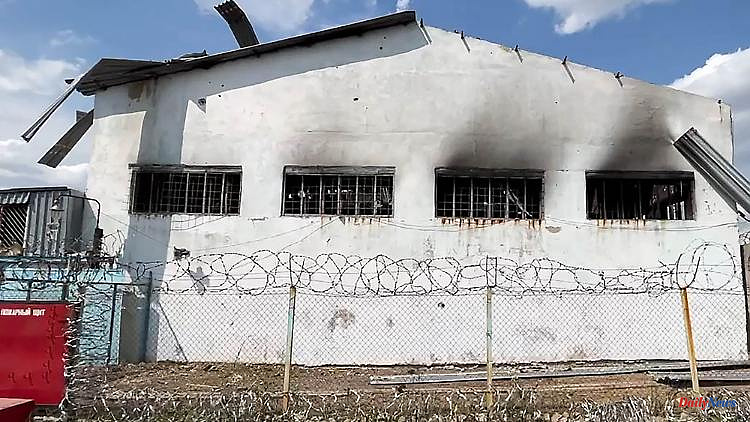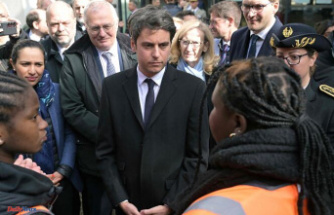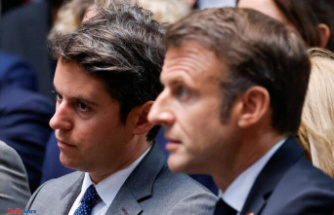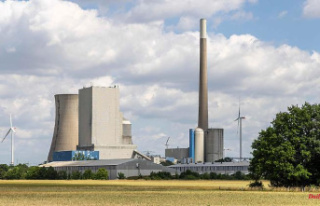On the night of Thursday to Friday, July 29, an explosion occurred east of the village of Olenivka. The incident takes place in a complex of buildings where up to a thousand Ukrainian prisoners of war are being held. The following morning, Russia reports dozens of dead and injured Ukrainians. Since the detonation of the building is not attributed to an accident - such as a gas explosion - but to shelling, it is a war crime: A building where both warring parties knew that numerous people were being held was obviously targeted shot at. But who is responsible for this crime? Both Russians and Ukrainians blame each other, seeing the mass murder as proof of how viciously and ruthlessly the other side is waging this war. Remotely available clues point more to Russia and its separatist allies as the perpetrators of this crime.
Who was killed? After Russian sources initially spoke of 40 dead and 75 injured, the number has now risen to more than 50 dead. The Russian Interior Ministry is also said to have published lists of names, but Ukrainian authorities warn that the list has not yet been checked. The Ukrainian military intelligence service initially assumed 40 dead and 130 injured. Video footage circulating online shows charred and shredded bodies amidst rubble. When the explosion happened, the victims were believed to have been sleeping on the numerous bunk beds, whose iron skeletons are still clearly visible. The camp is said to have mainly held members of the Azov regiment. This regiment, which emerged from a volunteer battalion with close ties to Ukrainian right-wing extremists, is repeatedly cited in Russian propaganda as evidence that a fascist regime is in power in Kyiv. In the defense of Mariupol and the local Azovstal steelworks, the Azov soldiers had tied up numerous Russian army forces for weeks.
What is this camp?
The penal colony Yelenovka - not to be confused with the place of the same name in Russia - is located south of the city of Donetsk in the Ukrainian Oblast of Donetsk. The region is almost completely under Russian control and operates as the supposedly independent Donetsk People's Republic, which is actually controlled and financed by Russia. According to Ukrainian information, the camp was already a prisoner of war camp before the 2014 war and was continued by the Donetsk separatists as a prisoner of war camp after 2014. It is a walled complex of buildings east of the village of Olenivka, in the far west of Donetsk Oblast. A group of former Ukrainian prisoners of war and relatives of detainees who have been exchanging information there since July 26 can be found on Telegram. The camp was publicly known as such.
What is the Russian rendering? On the very first day, the Russian authorities and state and state-related media made a commitment: the camp had been fired upon by the Ukrainian side using the US-supplied HIMARS mobile multiple rocket launcher. Andrey Rudenko, who as a front-line reporter is one of the best-known Russian war propagandists, was already circulating pictures from the camp the morning after the explosion. In the afternoon, Rudenko added a video clip showing fragments of fragments, alleged remains of a HIMARS projectile, laid out on a wooden bench. The problem: The scrap metal is no longer at the site where it was found, so it was not photographed at the supposed point of impact, although according to Rudenko state investigators were present to document the alleged war crimes committed by the Ukrainians.
What are the arguments of the Russian side? As recently as July 29, Rudenko made a direct link to videos he had distributed the same week, in which captured Azov soldiers reported murders of civilians under unclear circumstances, ordered by President Volodymyr Zelensky . Rudenko therefore claims that Kyiv used mass murder to prevent the prisoners from "talking". Leonid Miroshnik, who represents the self-proclaimed Luhansk People's Republic in Moscow, said according to Ria Novosti that Zelenskyy wanted to punish his own soldiers for surrendering to the Russians and also wanted to silence them.
What is the Ukrainian account? "The armed forces of the Russian Federation targeted artillery shelling at a prison in the settlement of Olenivka in the Donetsk region, where Ukrainian prisoners were also being held," the Ukrainian general staff said on July 29. The Ukrainian army leadership is assuming a "false flag" operation - a Russian act that Ukraine is supposed to be blamed for. For example, the Ukrainian population should be angered against their elected leadership and the supply of Western weapon systems should be disrupted. In fact, NATO countries only hand over their weapons under certain conditions, such as a ban on using the war material for attacks on Russian territory. The Ukrainian military intelligence service (GUR) even claimed that Yevgeny Prigozhin - the head of the mercenary company Wagner, who is close to Putin - ordered the attack to cover up the misappropriation of funds to care for prisoners of war. However, it remained unclear what Wagner was supposed to have to do with the care of prisoners of war in the People's Republic of Donetsk.
What are the arguments of the Ukrainian side? Kyiv denies having shelled the area that day and has received encouragement from numerous amateur investigators on the Internet who use freely available sources for reconnaissance (Open Source Intelligence, abbreviation OSINT). More on that in a moment. In principle, however, it seems more plausible that the Ukrainian side would hardly benefit from such a mass murder of their own people. The prisoners of war of the Azov regiment had been authorized to surrender from Kyiv, and the deaths of these fighters did not in the least turn the tide of the Russian propaganda mill. Finally, Russia is holding captive thousands of Ukrainians who, under unclear circumstances, have agreed to testify against Kyiv. But Kiev's account is not consistent either: there is no evidence of widespread artillery shelling of the camp, nor has it been reported so far that the Wagner group is involved in the care of prisoners of war.
What traces and clues can be interpreted?
The condition of the destroyed building is striking. It is said to be a new building into which the prisoners of war were transferred from the previously used cell blocks only two days before the attack. Only this one building exploded, and apparently quite in the middle - it would be a direct hit with just one shot. However, no impact crater can be seen in any of the images, and there does not appear to be any rubble around the building. Apart from the tin roof, the building structure has not been destroyed. The damage that can be seen in the videos distributed by the Russian side is evidence of great noise and heat build-up. But images of other, proven HIMARS impacts also show significant damage to walls and walls and impact craters. OSINT analysts therefore suspect a different cause of the explosion than HIMARS rockets. These could also come from the Ukrainian side, but why does the Russian side commit itself so early and decisively to HIMARS projectiles and present their supposed remains? It is also striking that, unlike many other attacks on both sides, no footage of the attack filmed by civilians has yet appeared on the Internet. Furthermore, no injuries were reported on the Russian or Donetsk side.
What do experts say? The day after the attack, the American Institute for the Study of War noted that the "images released by the Russian side show fire damage, but not the type of damage that a HIMARS attack would probably have caused." Available evidence would therefore rather support the Ukrainian version of events, but an independent judgment from afar is impossible. The International Committee of the Red Cross (ICRC) wanted to see the situation for itself, especially since the Geneva Convention requires the Red Cross to have access to prisoners of war at all times. According to the ICRC, however, this access was denied until Sunday afternoon. According to the Russian Foreign Ministry, the ICRC and representatives of the United Nations were invited to an independent investigation on Saturday. But the later investigators are left on site, the more difficult it is to take evidence.
Are there any other clues to the question of guilt? Basically, housing the prisoners of war only 10 to 15 kilometers behind the front is problematic. "Prisoners of war shall be removed as soon as possible after their capture to camps which are sufficiently distant from the combat zone to be out of danger," states Article 19 of the Third Geneva Convention. But: Depending on the ammunition, HIMARS could also shoot up to 300 kilometers, i.e. reach all other places in the self-proclaimed People's Republic of Donetsk. Since there was no direct fighting in the region during the days, there is no evidence of an accidental hit by either warring faction.
What remains? An information war has been raging on both sides for days. A Ukrainian video blogger who, with permission from the Defense Ministry, regularly interviews prisoners of war and demands confessions of remorse, humiliated several men by showing the Russians pictures from Olenivka and telling them that they would never be traded for Ukrainian prisoners of war. OSINT bloggers found evidence of graves on satellite images that had been dug on the camp site before July 28. They speculate that the Russian side wanted to cover up the murder and torture of the prisoners of war with the attack. On the Russian side, the footage of gruesome footage of the dead and wounded isn't fading away, intended to show how barbarically the supposedly fascist Ukraine treats its own people.
Like the massacre of civilians in Bucha or the attack on the maternity hospital in Mariupol, this crime also joins the long list of massacres in this war for which no one takes responsibility.












